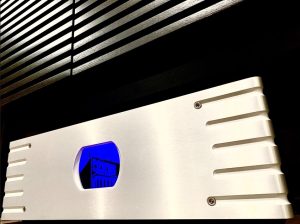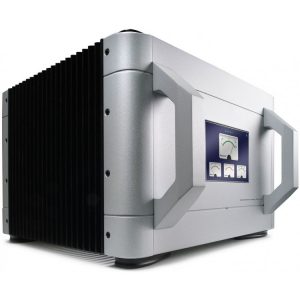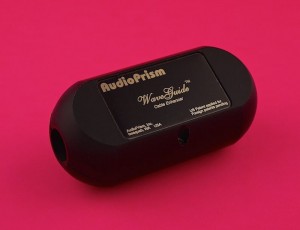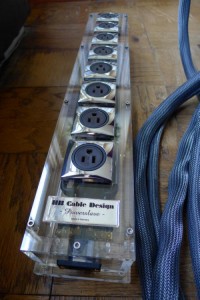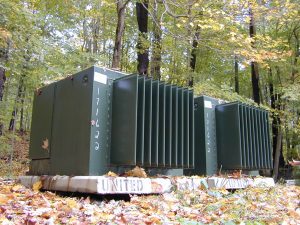I do not know if you remember our interview with Daniel Břeizina, the editor-in-chief of the Czech portal HiFi-Voice.com, published in the previous High Fidelity edition (No. 159, read HERE). Just in case, let me remind you that when he was asked for advice for a beginner music lover and audiophile, he said that it is best to start setting up an audio system by selecting elements connected with the mains and then to move on to the signal source, as these elements constitute the basis of every system. A balanced and sophisticated audio system can only be built on these foundations.
It is hard to disagree with him, but I would add something to it—something that Edwin van der Kley, the CEO of Siltech, talked about during his visit in Cracow: in fact, a system should be set up starting with cables. Although it would be easy to accuse him of being biased, as his company manufactures and sells cables, he is quite right in what he claims, as the first (even if not the most important) things in a system are: the mains, cables and the source. Most changes in the character are introduced by loudspeakers, while the amplifier is the centre of the system and controls everything. However, one needs to start setting up their dreamt-of audio system from the beginning and not the end.
It seems that we are not the only people who think this way, as the power supply market has grown rapidly and matured in the last several years. It is, I think, the effect of the maturity of the audio market and understanding certain relationships without looking at "learned theoreticians". However, it has also been caused by unprecedented mains pollution, mainly by the Internet and Wi-Fi networks, as well as the fact that files are more and more frequently used as the sound source. Systems that play files, both when streaming and local memory are used, are especially susceptible to RFI/EMI interference.
Network interference can be actively fought with, as exemplified by the Accuphase PS-530 active conditioner or a passive one, e.g. using mains filters. An example of the latter is the Acoustic Dream Ag-1 Premium passive conditioner. However, it is equally popular to eliminate interference, as well as vibrations, with the help of even more passive (if I can say so) methods. Two examples, where what matters are suitable sockets and suitable housings, as well as the materials which fill them, are Acoustic Revive RTP-4eu Ultimate and Verictum Cogitari power strips.
It is no coincidence, but both companies also offer separate passive power filters that are connected to a socket in the strip that we use, like, respectively, the RPC-1 or the X Block. Although a layperson might think it is a way of wangling money, both of the devices are based on solutions used in industry and in the army, where there is no place for mistakes. A similar solution, although in a much smaller form, is the Q1 filter manufactured by the Portuguese Qualia physic company.
A few simple words with…
JOÃO GRACIO, Owner, constructor
Qualia physic (this is the spelling that the company uses in their press materials—editorial note) is a company from Portugal, focusing on high-quality handmade audio products. Our most important activity is designing and making advanced line power supply units for high-end professional TV broadcasting and post-production systems. Other possibilities have recently become available for us, mostly because our products are capable of raising the quality of such devices as: audio servers, NAS disks and other ones. We have an experienced team that worked for years in Panasonic Broadcast, dealing with professional transfer of video signal and then moved on to high-end audio and power supply units making use of our own topology and techniques.
A few words about the Q1 filter: today's high-end systems are more and more demanding and sophisticated—so much that they have to be protected against external sources of interference/noise that comes from other devices and sources from our surroundings. Counteracting noise is an important element of our work, especially when it comes to electromagnetic interference (EMI) and electromagnetic compatibility (EMC).
The Q1 is a product which protects electronic devices against electromagnetically induced noise. The filter is built using a resonance system (LRC) designed by us, in which we have used high-quality sub-assemblies generating a passive electric field and minimizing the influence of interference coming from other devices connected to the same mains network.
At the moment we are working on an USB filter, while in the near future we want to present a digital-to-analog DSD converter in which we will apply our own solutions. Our aim is to create small product series in which we will be able to focus on quality and design carried out by our experienced employees using the best available materials.
Q1
The Q1 is a passive power filter in the form of a large mains plug. It actually is the Furutech FI-50(G) plug, i.e. one with gold-plated contacts made of a copper alloy subjected to heat treatment α (Alpha). Instead of a classic body, an element made of POM (polyoxymethylene, a polymer), used e.g. to make turntables, is attached to it. It has very good mechanical properties as it reduces vibrations and is easy to treat. It is wonderfully made in the Q1—this is what truly high-end products look like. The look is additionally enhanced by the interesting company logo.
According to company materials, the element made of POM is attached to the plug using appropriately adjusted force and the company does not advise its users to disassemble it. I do not know if this is an element of a policy which aims to protect the company's intellectual property or a real need. Just in case, I did not unscrew anything. However, it is known that inside there is a passive LRC system adjusted to reducing interference within the range of 70 – 150 kHz, i.e. where there is the most noise coming from impulse power supply units.
The company recommends connecting one unit to a power strip, using the socket which is the closest to the IEC socket where voltage from the wall socket is supplied. It is possible to use more than one Q1, but not next to one another—they should be separated with the socket where the power cable is plugged in. If there are two different power lines, e.g. for digital and analog devices, the company recommends using a separate filter for each. It is very important for the filter to be connected according to the symbols on the housing. The red circle symbolizes the pin that has got to be connected to the "hot" conductor—otherwise the filter will not function properly. One more thing—the Q1should be plugged in such a way that that there should be ca. 1 mm space between the plug and the socket, as the company recommends.
When the filter is connected for the first time, a moment (3 to 5 minutes) is needed for its parameters to stabilize. However, if the filter is new, it needs to be left in a system for as many as 350 – 400 hours.
TEST METHODOLOGY
Listening to the system with the Q1 filter required changing the applied methodology. Instead of the A/B/A comparison that I use, where A is the reference system and B is the tested element, I carried out a B/A comparison, as the filter needs up to 5 minutes to stabilize. So, I first connected the Q1 to an Acoustic Revive power strip, listened to a 2-minute fragment of a track, then unplugged the filter and listened to the same track again. Next, I plugged the filter back into the strip. I had a 5-minute break each time between subsequent tracks.
Let me remind you that I use the Acoustic Revive RTP-4eu Ultimate power strip (€4,300), with the Acrolink Mexcel 7N-PC9500 power cable (2.5 m, rhodium-plated contacts; 17,990 PLN/1.5 m), connected to the Furutech FT-SWS (R) wall socket. There is a separate power line (Oyaide Tunami Nigo, 6 m) connected to the socket, with a Hi-Fi Tuning fuse.
THE LISTENING SESSION
- Il Canto D'Orfeo, performed by Il Trionfo del Tempo, Et'Cetera | Klara KTC 4030, CD (2009)
- Frank Sinatra, Sinatra Sings Gershwin, Columbia/Legacy/Sony Music Entertainment 507878 2, CD (2003)
- Peter, Paul and Mary, In The Wind, Warner Bros. Records/Audio Fidelity AFZ 181, "Limited Edition | No. 0115", SACD/CD (1963/2014)
- Sohn, Tremors, 4AD/Hostess CAD3403CDJ, CD (2014)
The influence of the Q1 filter on sound may seem subtle, but it is repetitive and unambiguous. The subtlety of the changes that it introduces into sound mainly manifests itself by not changing the character of the sound, i.e. the filter is not going to be some kind of a "repair package"—if something in the system is not fully straightened out, the Q1 is not going to correct it, e.g. if tonal balance is shifted up or down, the filter will not raise or lower it.
However, the sound changes that we get with the Q1 are so interesting and valuable that I devoted a considerable amount of time both in order to determine what they consist in when I listened to the recordings selected for the test, and also to confirm that the changes also took place with subsequent albums that I listened to for pleasure. I suppose this is what using the filter is about—sound with the Q1 in the system is much more pleasant.
The first impression after we remove the filter and then connect it to the power strip again is that sound is grayer without it. The presence of the Q1 seems to bring out the actual colors of recordings. Each album that I listened to had its own character and the filter made it stronger, and more unambiguous—that did not involve "adding" anything to sound but rather presenting it freely, overcoming what might have been perceived as confinement before.
Almost simultaneously, I got the impression that sound without the filter in the system rushes somewhere, kind of "goes forward". Objectively, that was not true, as I know my system and I know it is neither nervous, nor "forward-moving". On the contrary, I would even say that, in comparison with many other systems, it is an oasis of peace and maturity. However, the Q1 showed that things can be done even better and what I perceived as absolute peace was in a way created and pretended. The effect of measures applied by Acoustic Revive and Acrolink was excellent (not many systems can boast about having anything like this!), as there was good dynamics, kick and drive. The filter "removed" that from sound or actually removed something artificial, as the dynamics, kick and drive remained but had more sense, naturally resulted from a given piece of music and were not imposed on everything, with all albums.
The most important changes take place in two areas: resolution and fill. The Portuguese filter gives sound more solid foundations. Everything is clearer and more unambiguous, while elements in space are better focused. That was the case both with the voice of Frank Sinatra from a mono recording from the year 1947 and a new production—the Tremors album. Each was aided in a slightly different way—e.g. when it comes to Sinatra, individual elements on the axis were better separated, i.e. the vocal, trumpet and orchestra, while as far as the Peter, Paul and Mary trio is concerned, vocals gained more freedom from the guitars that were earlier presented a little too close to one another.
Changes in tone color come across as very interesting. Actually, all the passive filters that I have had in my system raise the tone a little, shorten the base and sometimes more strongly articulate the treble, including sibilants. It is not that they are emphasized but have greater energy, thanks to which they seem to be stronger. Who knows, perhaps most of us make a mistake and set up a system building tonal balance without proper power supply.
Plugging in the Q1 showed that everything can be clearer, more filled and at the same time less packed and more distinct. At first sight, the treble is stronger with the filter, but only for a second, as a moment later you realize that everything is stronger and has more energy. And if there is too much treble or too little base, it is not the problem of the filter but our system, which is only revealed by the filter, i.e. the device attempts to reach the truth. And, according to a classic, the truth is beauty. Or the other way round, I do not remember…
At the beginning I mentioned that I got the impression of sound speeding up after I unplugged the filter. I think it is directly connected with what I am writing. Higher energy does not mean faster sound at all. Energy with fill results in stronger "presence" and tangibility, which, in turn, makes us more deeply and unambiguously convinced that what we hear is real. The fact that it is not real is, of course, clear—we are talking about mechanical reproduction of recorded music. However, in the audio domain we aspire to give up the disbelief as often as possible, so as to be as deeply convinced as possible inside us that we listen to real music and not ordered noise. The Q1 subtly but unambiguously helps us achieve this aim.
Conclusion
The Q1 manufactured by Qualia physic looks modest—it is an overgrown mains plug. However, using this filter results in very interesting effects that match a high-class audio system very well. They do not improve anything in it, as they are supposed to have impact on a given system without changing its character. Instead, they do something else—bring out those of its features that determine our engagement in music—energy, tangibility and fill. Although after a day or two we may forget that the Q1 once was an element of our system, plugging it in again brings back a slight improvement in quality and makes us wonder why we have not missed that, as the benefits of using the filter are clear.
Qualia physic
Price (at the time of the test): €320/unit (+VAT)
MADE IN EU
Text: Wojciech Pacuła
Photos: Wojciech Pacuła
Translation: Ewa Muszczynko














